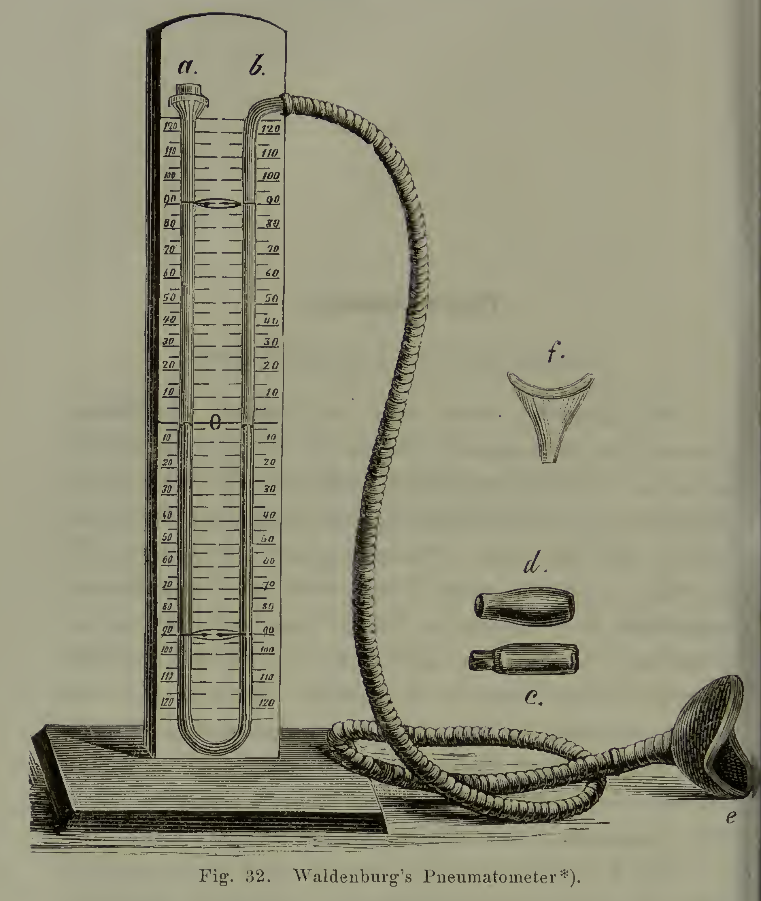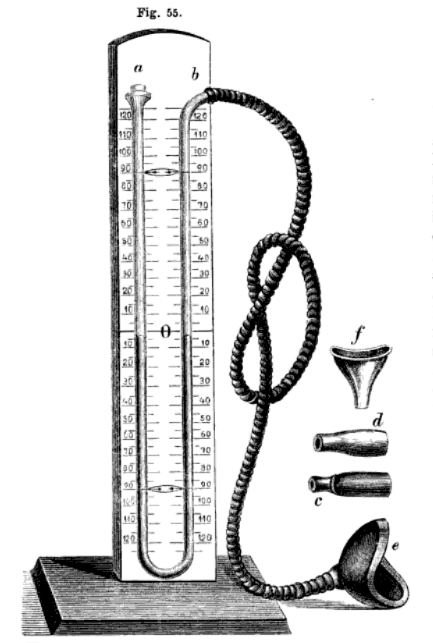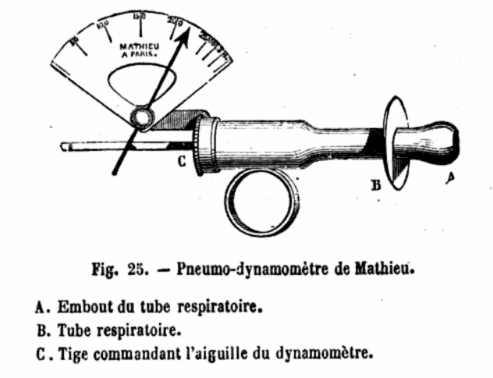
Designed to measure inspiratory and expiratory pressures. From ‘Handbuch der pneumatischen therapie’, by Dr. Theodore Knauth, published 1876, page 282.

Designed to measure inspiratory and expiratory pressures. From ‘Handbuch der pneumatischen therapie’, by Dr. Theodore Knauth, published 1876, page 282.

A U-tube manometer for measuring inspiratory and expiratory pressures. A variety of mouthpieces and masks used with it are shown. From “Real-encyclopedia of the Entire Obstetrics” , Volume 15, by Urban & Schwarzenberg , published 1888, page 657.

An expiratory pressure gauge. From “Arsenal du diagnostic médical: recherches sur les thermomètres, les balances, les instruments d’exploration des organes respiratoires, de l’appareil cardio-vasculaire, du système nerveux, les spéculums uteri et les laryngoscopes” by Maurice Jeannel, published by Balliere, 1873, page 91.
From “A Treatise on Hygiene with special reference to the military service”, by William Alexander Hammond (Surgeon-General, U.S. Army.), published 1863, page 48.
“The haemodynamometer enables us to determine both the expiratory and inspiratory power, and is therefore more useful (figure 9). It consists of a bent tube of glass, attached to a scale graduated for both sides. An India-rubber tube is attached to one end of the glass tube, to which a suitable mouthpiece is affixed. Mercury is poured into the glass tube till the zero on both scales is reached. Upon expiring into the arrangement, the mercury is forced to rise in the opposite portion of the tube, and is correspondingly depressed in the portion to which the elastic tube is attached. When the act of inspiration is performed, the opposite movements of the mercury takes place. The same precautions are requisite as in using the cardiometer.
“The height to which the mercury be raised is greater by expiratory than by inspiratory efforts. A healthy man, five feet eight inches high, can raise the column of mercury about three inches by expiration, and about two inches by inspiration.”
From “A Treatise on Hygiene with special reference to the military service”, by William Alexander Hammond (Surgeon-General, U.S. Army.), published 1863, page 47.
“The respiratory power of an individual may be ascertained by the cardiometer or haemodynamometer. The former, modified somewhat for its present use, is represented in figure 8. It consists of an iron bottle, having a hollow arm at one side, communicating both with the cavity of the bottle and with a glass tube, open at both ends, to which a graduated scale is attached. The mouth of the bottle is closed with a tight-fitting cork, through which a brass tube is passed. This tube is connected with one piece of India-rubber, having a mouthpiece. Sufficient mercury is placed in the bottle to reach the zero on the scale, and upon applying the mouth to the end of the tube, and breathing through it, the mercury rises in the glass tube. Several points must be observed in using this instrument. The joints must all be air-tight, and, above all, care must be taken to exert only the muscles of the chest, and not those of the mouth and cheeks. This instrument only measures the expiratory power.”
A recording mercury U-tube manometer. The float in the left side of the U-tube moves up and down in response to respiratory pressures. The thin metal rod attached to the float had a recording pen at its tip.
From Das Stottern. Eine Monographie für Aerzte, Pädagogen und Behörden by Hermann Gutzmann, published by Rosenheim, 1898. page 149.